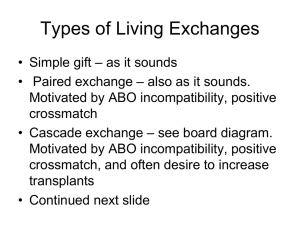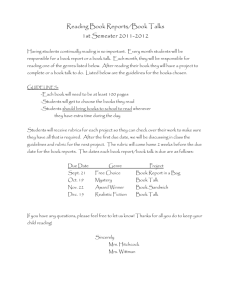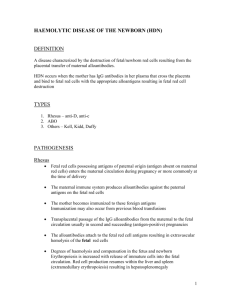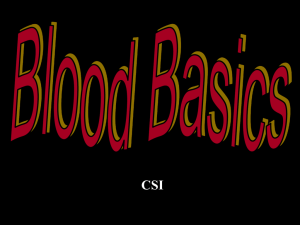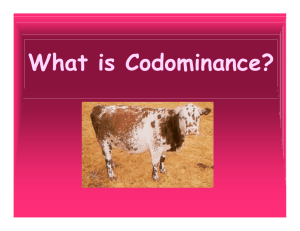FORM : 5 DATE : 09/12/2014 SUBJECT : Biology TIME : THEME
advertisement
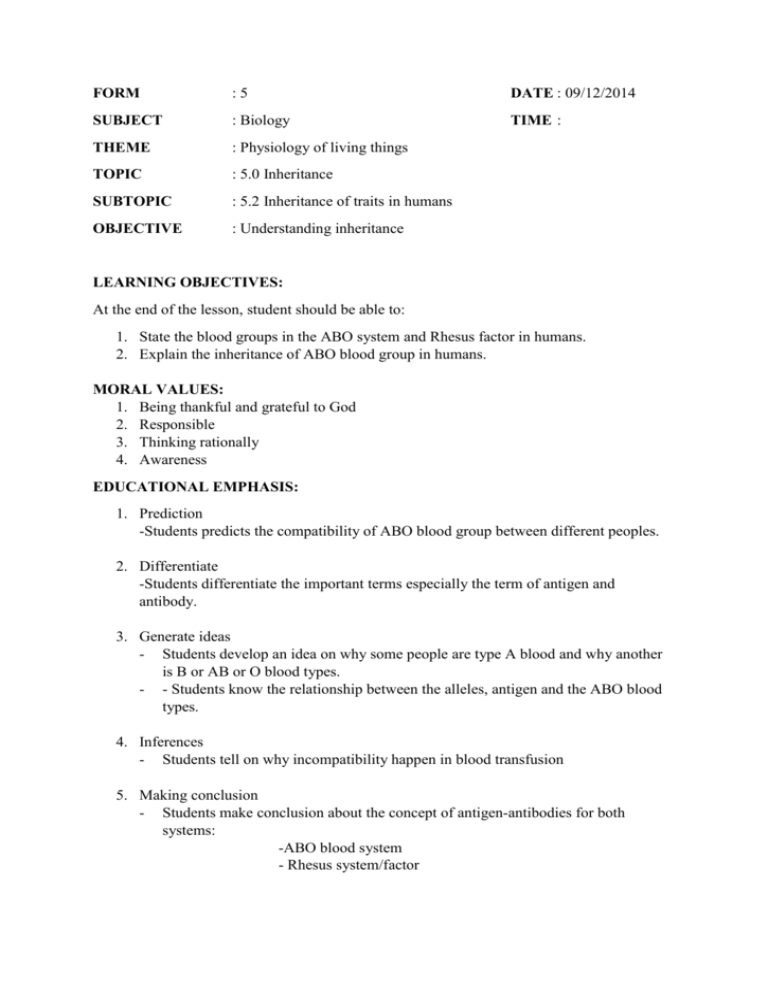
FORM :5 DATE : 09/12/2014 SUBJECT : Biology TIME : THEME : Physiology of living things TOPIC : 5.0 Inheritance SUBTOPIC : 5.2 Inheritance of traits in humans OBJECTIVE : Understanding inheritance LEARNING OBJECTIVES: At the end of the lesson, student should be able to: 1. State the blood groups in the ABO system and Rhesus factor in humans. 2. Explain the inheritance of ABO blood group in humans. MORAL VALUES: 1. Being thankful and grateful to God 2. Responsible 3. Thinking rationally 4. Awareness EDUCATIONAL EMPHASIS: 1. Prediction -Students predicts the compatibility of ABO blood group between different peoples. 2. Differentiate -Students differentiate the important terms especially the term of antigen and antibody. 3. Generate ideas - Students develop an idea on why some people are type A blood and why another is B or AB or O blood types. - - Students know the relationship between the alleles, antigen and the ABO blood types. 4. Inferences - Students tell on why incompatibility happen in blood transfusion 5. Making conclusion - Students make conclusion about the concept of antigen-antibodies for both systems: -ABO blood system - Rhesus system/factor INSTRUCTIONAL AIDS: 1. Whiteboard and marker pen 2. Manila cards 3. Polystyrene –ABO/RBC model PREVIOUS KNOWLEDGE: Students have learnt about the shape of red blood cell, four types of blood group in human and familiar with the word of universal donor and universal recipient. (Science form 3, chapter 2: Blood circulation) REFERENCES: Chang, T. H., Yasin, Y., Hamzah, F.,Kho, C.Q., Lou, S. D., Entain, L., Arif, N. A., Ismail, N., Ali, R., Young, K. S., Rosli, Z. (2014). SPM Biology Form 5. Sasbadi sdn.Bhd. TEACHING PROCEDURE: STAGE IINDUCTION SET ( 3 minutes) TEACHER’S ACTIVITIES 1. Teacher greets all the students. 2. Teacher draws a picture of a thief/unknown person enter one house. -Teacher explains the image or the situation. 3. Teacher asks students what they will do if the thief / unknown person enter their house. 4. Teacher asks again, what happen or what will the students do if their relatives come to their house. 5. Teacher tells the concept of immune system (antigen-antibody) is just like the story. 6. Teacher begins the lesson by rolling the students on what they will learn today. STUDENT’S ACTIVITIES 1. Students greet the teacher. 2. Students focus and answer the questions of the teacher. 3. Students answer that they will fight back or stimulates selfdefences/protection towards the thief/unknown person. 4. Students answer that they welcoming their relative to their house because they know and recognize them.(Nothing bad happened) 5. Students have the idea from the story. 6. Students get ready to learn for today’s lesson. DEVELOPMENT ( 14 Minutes) 1. Teacher divides the lesson into 2 major parts. 2. Teacher distributes a hand-out containing the guideline about today's lesson. -Teacher reminds students to be focus and understand all the concepts and term given. 3. Teacher continues the lesson with the explanation of determination for i) Blood group: -blood transfusion - ABO group diagram - Teacher uses the polystyrenes RBC model to illustrates the blood group and explain the blood transfusion. ii) Rhesus factor -Rh positive 1. Students focus on the lesson. 2. Students read and understand the terms and concepts given by teacher. 3. Student pay attention on the lesson or explanation from teacher. -Students focus on the polystyrenes RBC model and the explanation. - Students pay attention on the Rhesus factor explanation by manila card. 4. Students recall the concept. -Students using the concept to understand the relationship between antigen-antibody. - Rh negative - Teacher uses manila card which contents the story of Rhesus factor to explain about the Rhesus system. 4. Teacher recalls about the concept discussed at the beginning classes. - Teacher informs students to using the concept in other to understand the antigen-antibody relationship. ACTIVITY 1 1. Teacher creates a situation which required 2 individual/students and have a different blood types. - Teacher asks the blood types for both student. - One become a donor and another become a recipient. 1. Students pay attention to the teacher’s instruction. - Two students come to front (one as a donor and another as a recipient). - The two students tell their blood types. - CONCLUSION ( 3 minutes) Teacher calls for a volunteer to determine if there blood types are compatible with each other’s or not. (Explanation by using RBC model) 1. Teacher summarizes the lesson by asking students what had been learned today. - - One become a donor and another become recipient. A volunteer explain and determine the compatibility for both blood by using RBC model. 2. Students give respond on what they had learned. FOLLOW-UP ACTIVITY: - Teacher asks students to review the chapter 5 since the topic is quite confusing for students (The concepts should be grasp well). SELF-EVALUATION: - Students can understand the lesson and appreciated the values and aware about the important of blood group knowledge. SUPERVISORS’ COMMENTS:

